Related Research Articles

Nuno Gonçalves was a Portuguese artist whose work initiated the Portuguese Renaissance in painting. He was court painter for Afonso V of Portugal from 1450 to 1471, and in 1471 he was appointed the official painter for the city of Lisbon. His surviving masterpiece is the polyptych known as the Saint Vincent Panels.

The Calouste Gulbenkian Museum houses one of the world's most important private art collections. It includes works from Ancient Egypt to the early 20th century, spanning the arts of the Islamic World, China and Japan, as well as the French decorative arts, Impressionist painting and the jewellery of René Lalique.

Vasco Navarro da Graça Moura, GCSE GCIH OSE was a Portuguese lawyer, writer, translator and politician, son of Francisco José da Graça Moura and wife Maria Teresa Amado da Cunha Seixas Navarro de Castro, of Northern Portugal bourgeoisie.

Belém Tower, officially the Tower of Saint Vincent is a 16th-century fortification located in Lisbon that served as a point of embarkation and disembarkation for Portuguese explorers and as a ceremonial gateway to Lisbon. It was built during the height of the Portuguese Renaissance, and is a prominent example of the Portuguese Manueline style, but it also incorporates hints of other architectural styles. The structure was built from lioz limestone and is composed of a bastion and a 30-metre (100 ft), four-storey tower.
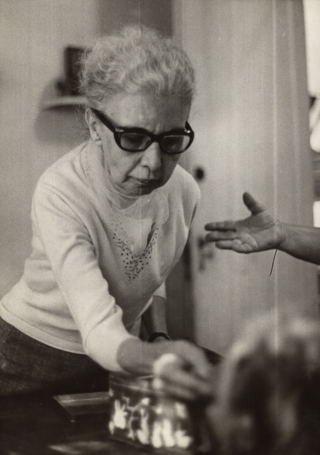
Nise da Silveira was a Brazilian psychiatrist and a student of Carl Jung. She devoted her life to psychiatry and has never been in agreement with the aggressive forms of treatment of her time such as commitment to psychiatric hospitals, electroshock, insulin therapy and lobotomy.

Azulejo is a form of Spanish and Portuguese painted tin-glazed ceramic tilework. Azulejos are found on the interior and exterior of churches, palaces, ordinary houses, schools, and nowadays, restaurants, bars and even railways or subway stations. They are an ornamental art form, but also had a specific functional capacity like temperature control in homes.

The Palace of Ajuda is a neoclassical monument in the civil parish of Ajuda in the city of Lisbon, central Portugal. Built on the site of a temporary wooden building constructed to house the Royal family after the 1755 earthquake and tsunami, it was originally begun by architect Manuel Caetano de Sousa, who planned a late Baroque-Rococo building. Later, it was entrusted to José da Costa e Silva and Francisco Xavier Fabri, who planned a magnificent building in the modern neoclassical style.
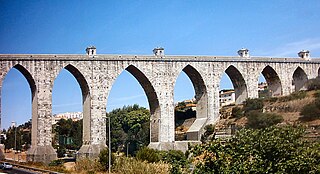
The Águas Livres Aqueduct is a historic aqueduct in the city of Lisbon, Portugal. It is one of the most remarkable examples of 18th-century Portuguese engineering. The main course of the aqueduct covers 18 km, but the whole network of canals extends through nearly 58 km.
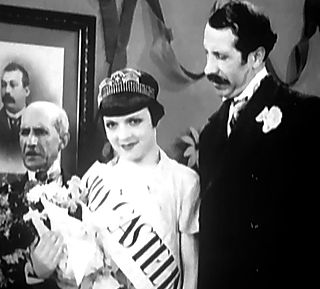
Comédia à portuguesa is a term conventionally used to refer to the genre of popular Portuguese film comedies made in the 1930s and 1940s. The light-hearted comedies are predominantly set in petit-bourgeois milieus in traditional Lisbon neighbourhoods and are often accompanied by musical performances, mainly light music, fados or folk songs. The popular revue, the national equivalent of the North American vaudeville or the British music hall, had a marked influence over the comédia à portuguesa, including the talents of the actors, writers, and musicians.

Josefa de Óbidos was a Spanish-born Portuguese painter. Her birth name was Josefa de Ayala Figueira, but she signed her work as "Josefa em Óbidos" or "Josefa de Ayalla". All of her work was executed in Portugal, her father's native country, where she lived from the age of four. Approximately 150 works of art have been attributed to Josefa de Óbidos, making her one of the most prolific Baroque artists in Portugal.

Katia Guerreiro is a South African-born Portuguese fado singer, who has released eight albums and has received several awards, including Order of Arts and Letters, Chevalier rank, from the French government and the Order of Prince Henry from the President of Portugal.

Francisco de Holanda was a Portuguese artist, architect, and art essayist. He served as a court painter for the kings João III of Portugal and Sebastião of Portugal. He was an influential figure in the Portuguese Renaissance. After a stay in Italy, he returned to Portugal and contributed to the propagation of the Italianate style mainly through his writings. In 1548 he completed a manuscript entitled Da pintura antigua which was the first treatise on painting written in the Iberian peninsula.

The Platine War was fought between the Argentine Confederation and an alliance consisting of the Empire of Brazil, Uruguay, and the Argentine provinces of Entre Ríos and Corrientes, with the participation of the Republic of Paraguay as Brazil's co-belligerent and ally. The war was part of a decades-long dispute between Argentina and Brazil for influence over Uruguay and Paraguay, and hegemony over the Platine region. The conflict took place in Uruguay and northeastern Argentina, and on the Río de la Plata. Uruguay's internal troubles, including the longrunning Uruguayan Civil War, were heavily influential factors leading to the Platine War.
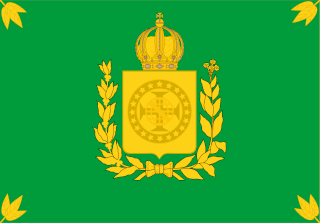
The Armed Forces of the Empire of Brazil were the overall unified military forces of the Empire of Brazil. The Brazilian military was first formed by Emperor Dom Pedro I to defend the new nation against the Portuguese in the Brazilian War of Independence. The Army and Armada were commissioned in 1822 with the objective of defeating and expelling the Portuguese troops from Brazilian soil.

Miguel da Silva was a Portuguese nobleman, the second son of Diogo da Silva, 1st Count of Portalegre and of his wife Maria de Ayala, a Castilian noblewomen. He was ambassador of the king of Portugal to several popes, and papal ambassador to the Emperor and others.

The Roman Dam of Belas is a 3rd-century Roman barrier constructed to serve the city of Olisipo, located in civil parish of Queluz e Belas, municipality of Sintra.
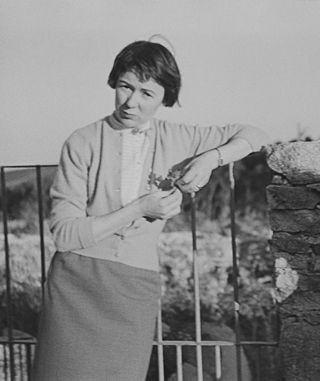
Maria Keil was a Portuguese visual artist. She was born in Silves and died in Lisbon.
de Zwart is a Dutch surname, meaning "the black (one)", usually having referred to dark hair. Variant forms include De Swart, De Swarte and De Zwarte. People with these names include:
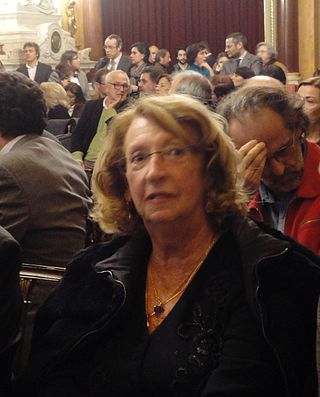
Helena AlmeidaGOIH was a Portuguese artist known for her work in photography, performance art, body art, painting and drawing.

The Imperial Brazilian Navy was the navy created at the time of the independence of the Empire of Brazil from the United Kingdom of Portugal, Brazil and the Algarves. It existed between 1822 and 1889 during the vacancy of the constitutional monarchy.
References
- ↑ Deswarte-Rosa, Sylvie (2006). "Prisca pictura e antiqua novitas Francisco de Holanda e a taxonomia das figuras antigas". ARS. São Paulo. 4 (7): 14–27. doi: 10.1590/S1678-53202006000100002 .
- ↑ "Sylvie Deswarte-Rosa at CNRS" . Retrieved 25 November 2015.